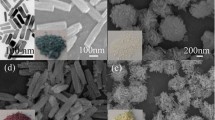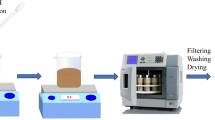Abstract
The detection of lung cancer via the analysis of volatile organic compounds (VOCs) in exhaled breath has attracted a lot of attention as it is simple and non-invasive for the patients. Among the numerous VOCs exist in the breath, isopropanol is believed to be an important biomarker that can help to discriminate between healthy and unhealthy people. In this work, a highly sensitive Fe-doped ZnO nanoneedles-based gas sensor was studied for the detection of isopropanol at low concentrations (below 10 ppm). The pure and Fe-doped ZnO were synthesized via a hydrothermal method and spray-coated onto an alumina substrates equipped with a pair of gold interdigitated electrodes. The morphologies of the sensing layers were characterized by SEM, while the phase structure and composition were determined by XRD. The sensing properties of pure and Fe-doped ZnO were investigated under different temperatures and concentrations. It is found that Fe doping significantly increased the sensing performance of ZnO nanoneedles. The optimal doping concentration of Fe is 5 at% for isopropanol detection, and the optimal working temperature is 275 °C. The sensor showed a high response to 250 ppb isopropanol, together with high stability under different humidity levels.

















Similar content being viewed by others
References
Allemani C et al (2018) Global surveillance of trends in cancer survival 2000–14 (CONCORD-3): analysis of individual records for 37 513 025 patients diagnosed with one of 18 cancers from 322 population-based registries in 71 countries. Lancet 391:1023–1075
Ghezzi S, Martinelli E, Roscioni C, Lucantoni G, Galluccio G, Paolesse R, Di Natale C, D’Amico A (2015) The lung cancer breath signature: a comparative analysis of exhaled breath and air sampled from inside the lungs. Sci Rep 5:16491–16501
Filipiak W, Filipiak A, Sponring A, Schmid T, Zelger B, Ager C, Klodzinska E, Denz H, Pizzini A, Lucciarini P, Jamnig H, Troppmair J, Amann A (2014) Comparative analyses of volatile organic compounds (VOCs) from patients, tumors and transformed cell lines for the validation of lung cancer-derived breath markers. J Breath Res 8:027111–027124
O’Neill H, Gordon S, O’Neill M, Gibbons R, Szidon J (1988) A computerized classification technique for screening for the presence of breath biomarkers in lung cancer. Clin Chem 34:1613–1618
Ligor M, Ligor T, Bajtarevic A, Ager C, Pienz M, Klieber M, Denz H, Fiegl M, Hilbe W, Weiss W, Lukas P, Jamnig H, Hackl M, Buszewski B, Miekisch W, Schubert J, Amann A (2009) Determination of volatile organic compounds in exhaled breath of patients with lung cancer using solid phase microextraction and gas chromatography mass spectrometry. Clin Chem Lab Med 47:550–560
Song G, Qin T, Liu H, Xu G, Pan Y, Xiong F, Gu K, Sun G, Chen Z (2010) Quantitative breath analysis of volatile organic compounds of lung cancer patients. Lung Cancer 67:227–231
Schallschmidt K, Becker R, Jung C, Bremser W, Walles T, Neudecker J, Leschber G, Frese S, Nehls I (2016) Comparison of volatile organic compounds from lung cancer patients and healthy controls—challenges and limitations of an observational study. J Breath Res 10:046007–046024
Mazzone P, Hammel J, Dweik R, Na J, Czich C, Laskowski D, Mekhail T (2007) Diagnosis of lung cancer by the analysis of exhaled breath with a colorimetric sensor array. Thorax 62:565–568
Wehinger A, Schmid A, Mechtcheriakov S, Ledochowski M, Grabmer C, Gastl G, Amann A (2007) Lung cancer detection by proton transfer reaction mass-spectrometric analysis of human breath gas. Int J Mass Spectrom 265:49–59
Kischkel S, Miekisch W, Sawacki A, Straker E, Trefz P, Amann A, Schubert J (2010) Breath biomarkers for lung cancer detection and assessment of smoking related effects—confounding variables, influence of normalization and statistical algorithms. Clin Chim Acta 411:1637–1644
Rudnicka J, Walczak M, Kowalkowski T, Jezierski T, Buszewskia B (2014) Determination of volatile organic compounds as potential markers of lung cancer by gas chromatography–mass spectrometry versus trained dogs. Sens Actuat B Chem 202:615–621
Poli D, Goldoni M, Corradi M, Acampa O, Carbognani P, Internullo E, Casalini A, Muttia A (2010) Determination of aldehydes in exhaled breath of patients with lung cancer by means of on-fiber-derivatisation SPME–GC/MS. J Chromatogr B 878:2643–2651
Buszewski B, Ligor T, Jezierski T, Wenda-Piesik A, Walczak M, Rudnicka J (2012) Identification of volatile lung cancer markers by gas chromatography–mass spectrometry: comparison with discrimination by canines. Anal Bioanal Chem 404:141–146
Saalberg Y, Wolff M (2016) VOC breath biomarkers in lung cancer. Clin Chim Acta 459:5–9
Kaur J, Anand K, Anand K, Singh R (2018) WO3 nanolamellae/reduced graphene oxide nanocomposites for highly sensitive and selective acetone sensing. J Mater Sci 53:12894–12907. https://doi.org/10.1007/s10853-018-2558-z
Duan H, Wang Y, Li S, Wang Y, Li S, Li H, Liu L, Du L, Cheng Y (2018) Controllable synthesis of Ho-doped In2O3 porous nanotubes by electrospinning and their application as an ethanol gas sensor. J Mater Sci 53:3267–3279. https://doi.org/10.1007/s10853-017-1796-9
Dey A (2018) Semiconductor metal oxide gas sensors: a review. Mater Sci Eng B 229:206–217
Zhang C, Wu Q, Zheng B, You J, Luo Y (2018) Synthesis and acetone gas sensing properties of Ag activated hollow sphere structured ZnFe2O4. Ceram Int 44:20700–20707
You J, Chen X, Zheng B, Geng X, Zhang C (2017) Suspension Plasma-Sprayed ZnFe2O4 Nanostructured Coatings for ppm-Level Acetone Detection. J Therm Spray Technol 26:728–734
Li W, Wu X, Han N, Chen J, Qian X, Deng Y, Tang W, Chen Y (2016) MOF-derived hierarchical hollow ZnO nanocages with enhanced low-concentration VOCs gas-sensing performance. Sens Actuat B Chem 225:158–166
Chen Y, Li X, Li X, Wang J, Tang Z (2016) UV activated hollow ZnO microspheres for selective ethanol sensors at low temperatures. Sens Actuat B Chem 232:158–164
Hsu C, Jhang B, Kao C, Hsueh T (2018) UV-illumination and Au-nanoparticles enhanced gas sensing of p-type Na-doped ZnO nanowires operating at room temperature. Sens Actuat B Chem 274:565–574
Kim J, Kim S (2015) Realization of ppb-scale toluene-sensing abilities with Pt functionalized SnO2-ZnO core-shell nanowires. ACS Appl Mater Interfaces 7(31):17199–17208
Drobek M, Kim J, Bechelany M, Vallicari C, Julbe A, Kim S (2016) MOF-based membrane encapsulated ZnO nanowires for enhanced gas sensor selectivity. ACS Appl Mater Interfaces 8(13):8323–8328
Wang Z, Tian Z, Han D, Gu F (2016) Highly sensitive and selective ethanol sensor fabricated with In-doped 3DOM ZnO. ACS Appl Mater Interfaces 8(8):5466–5474
Guo W, Zhao B, Zhou Q, He Y, Wang Z, Radacsi N (2019) Fe-doped ZnO/reduced graphene oxide nanocomposite with synergic enhanced gas sensing performance for the effective detection of formaldehyde. ACS Omega 4:10252–10262
Khayatian A, Safa S, Azimirad R, Almasi Kashi M, Akhtarianfar SF (2016) The effect of fe-dopant concentration on ethanol gas sensing properties of Fe-doped ZnO/ZnO shell/core nanorods. Physica E 84:71–78
Han L, Wang D, Lu Y, Jiang T, Liu B, Lin Y (2011) Visible-light-assisted HCHO gas sensing based on Fe-doped flowerlike ZnO at room temperature. J Phys Chem C 115:22939–22944
Yu A, Qian J, Pan H, Cui Y, Xu M, Tu L, Chai Q, Zhou X (2011) Micro-lotus constructed by Fe-doped ZnO hierarchically porous nanosheets: preparation, characterization and gas sensing property. Sens Actuat B Chem 158:9–16
Machado R, Laskowski D, Deffenderfer O, Burch T, Zheng S, Mazzone P, Mekhail T, Jennings C, Stoller J, Pyle J, Duncan J, Dweik R, Erzurum S (2005) Detection of lung cancer by sensor array analyses of exhaled breath. Am J Respir Crit Care Med 171:1286–1291
Bai S, Guo T, Zhao Y, Sun J, Li D, Chen A, Liu C (2014) Sensing performance and mechanism of Fe-doped ZnO microflowers. Sens Actuat B Chem 195:657–666
Zhang C, Geng X, Liao H, Li C, Debliquy M (2017) Room-temperature nitrogen-dioxide sensors based on ZnO1−x coatings deposited by solution precursor plasma spray. Sens Actuat B Chem 242:102–111
Zhang C, Geng X, Li J, Luo Y, Lu P (2017) Role of oxygen vacancy in tuning of optical, electrical and NO2 sensing properties of ZnO1-x coatings at room temperature. Sens Actuat B Chem 248:886–893
Zhang W, Zhang W, Zhou J (2010) Solvent thermal synthesis and gas-sensing properties of Fe-doped ZnO. J Mater Sci 45:209–215. https://doi.org/10.1007/s10853-009-3920-y
Huang S, Wang T, Xiao Q (2015) Effect of Fe-doping on the structural and gas sensing properties of ZnO porous microspheres. J Phys Chem Solids 76:51–58
Zhang M, Zhen Y, Sun F, Xu C (2016) Hydrothermally synthesized SnO2-graphene composites for H2 sensing at low operating temperature. Mat Sci Eng B Adv 209:37–44
Ji H, Zeng W, Li Y (2019) Gas sensing mechanisms of metal oxide semiconductors: a focus review. Nanoscale 11:22664–22684
Zhang B, Fu W, Meng X, Ruan A, Su P, Yang H (2018) Synthesis of actinomorphic flower-like SnO2 nanorods decorated with CuO nanoparticles and their improved isopropanol sensing properties. Appl Surf Sci 456:586–593
Bârsan N, Hübner M, Weimar U (2011) Conduction mechanisms in SnO2 based polycrystalline thick film gas sensors exposed to CO and H2 in different oxygen backgrounds. Sens Actuat B Chem 157:510–517
Acknowledgements
This work is financially supported by the Natural Science Foundation of China under Grant No. 51872254, the National Key Research and Development Program of China under Grant No. 2017YFE0115900, the European Regional Development Fund (ERDF) and the Walloon Region of Belgium through the Interreg V France-Wallonie-Vlaanderen program, under PATHACOV project (No. 1.1.297) and the Micro+ project co-funded by the European Regional Development Fund (ERDF) and Wallonia, Belgium (No. 675781-642409).
Author information
Authors and Affiliations
Corresponding authors
Additional information
Handling Editor: Joshua Tong.
Publisher's Note
Springer Nature remains neutral with regard to jurisdictional claims in published maps and institutional affiliations.
Rights and permissions
About this article
Cite this article
Luo, Y., Ly, A., Lahem, D. et al. A novel low-concentration isopropanol gas sensor based on Fe-doped ZnO nanoneedles and its gas sensing mechanism. J Mater Sci 56, 3230–3245 (2021). https://doi.org/10.1007/s10853-020-05453-1
Received:
Accepted:
Published:
Issue Date:
DOI: https://doi.org/10.1007/s10853-020-05453-1




